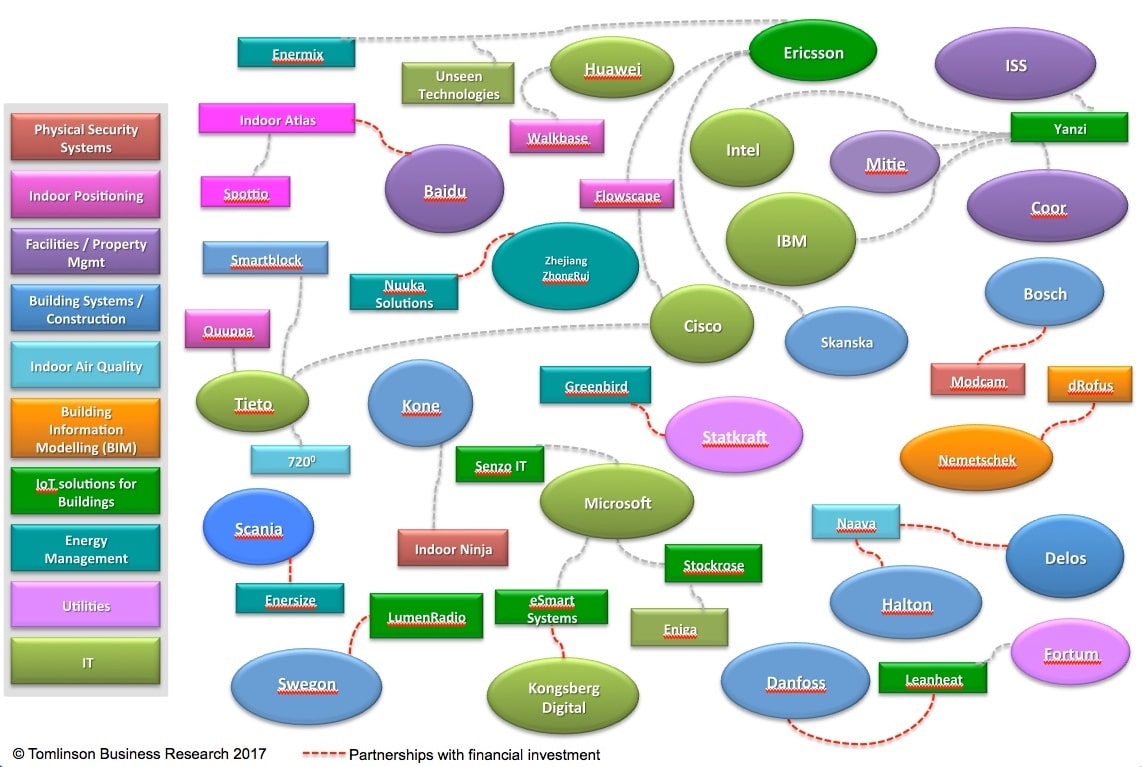This article was written by Daphne Tomlinson of Tomlinson Business Research
Startups and established players alike gathered in Helsinki earlier this month at the Nordic Smart Building Convention to discuss the state of the market for intelligence, digitalization and autonomous sensing in the built environment. This article aims to give a few highlights of the meeting.
The event was organized by HUB13, a Finnish startup accelerator, providing the leading co-working space in Finland. The convention arose out of the organization's annual REWORK event, the Helsinki Future Workplace Summit, which focuses on the future of work and the workplace.
Event participants included representatives from the AEC sector, building systems vendors, FM and workplace management service firms, IT companies and academia. Three themes recurred throughout the two day event:
Smart Buildings are Occupant Focused and Healthy
Tomi Teikko, Director of Intelligent Building at Tieto, a leading Nordic software and services company, presented his view of "The Human as the Most Advanced Sensor". He highlighted Tieto’s Keilalahti campus which has transformed from a traditional office to a data driven activity based working environment. With no allocated desks, the IoT solution supports occupants with wayfinding, location analytics and room booking. The occupants also act as an IoT sensor themselves, giving feedback on preferences relating to temperature, air quality, tools or furniture, noise and other factors. Solutions from Finnish startups, 720° and Quuppa are incorporated into the overall solution.
Joe Paradiso, Professor in Media Arts and Sciences, Responsive Environments Group, MIT Media Lab gave an inspiring and entertaining presentation on his students' work with sensors and wearable technologies, exploring how sensor networks augment and mediate human experience, interaction, and perception, including those applied to assessing the mood of individuals whilst working and using visual stimuli such as calming landscapes and seascapes to enhance the productivity of the individual.
Matthew Marson, Consultant in Accenture's Connected Spaces practice presented their Connected Building project at The Dock, Dublin, a multidisciplinary research and incubation hub with 200 designers, developers and experts in artificial intelligence, analytics and IoT. The 60,000 sq.ft. building contains over 12,000 sensors intelligently monitoring elements such as lighting, temperature, occupancy, CO2, humidity and motion, enabling employees to more easily connect with each other and clients, configure meeting and work spaces and establish what people and skills are at their disposal. The building uses CPAAS—Connected Platform as a Service—Accenture’s own IoT platform — as its glue and “brain”.
Connected Building Technologies are Diverse
The range and diversity of Nordic startups offering technology solutions for buildings and workplace occupants was apparent. IoT platforms, AI, augmented and virtual reality, indoor positioning systems and UAVs were some of the key technologies presented by the 20 startups exhibiting in the arena. For example:
- Tridify, a collaboration, sales & management tool for the AEC industry. Their cloud software takes BIM data and 3D assets, integrates them with virtual and augmented reality technologies to deliver immersive and interactive VR environments. Aimed at property developers, real estate owners and investors.
- Moodmetric, a Smart office tool, which offers a corporate wellbeing service for companies wishing to actively prevent excessive stress within their organizations. The Moodmetric ring and app enable personalized stress data analytics for high performing individuals who want to learn to balance stress effectively.
- Nuuka, a Finnish SaaS company established in 2013, offering a cloud based analytics platform for commercial and public buildings to centrally monitor and manage the energy efficiency, indoor air quality and HVAC performance of an entire real estate portfolio.
- Arctic Robotics, an early stage Finnish startup founded in 2016 providing fully autonomous indoor security with a drone service targeting the interior of commercial buildings, such as warehouses, shopping malls, stadiums and airports.
Ecosystem Partners are Essential to Achieve the Full Potential of Intelligent Buildings
My presentation summarized the highlights of the recent Memoori report on Startups in Smart Buildings. One key global finding was the increased level of collaboration between established players and startups in the last two years, driven by the desire for co-development, the need to increase speed of innovation and to scout and select disruptive ideas.
Collaboration in the Nordic region over the last two years confirmed this global trend. Kone is currently engaged in establishing strong ecosystems with partners to achieve a wider set of capabilities and to enable faster innovation, according to Sami Vesala, New Equipment Business Director, Kone Corporation. The company is also partnering with startups such as Indoor Ninja, an Estonian developer of a digital office receptionist for visitor identification and access control through the elevator. While most access control systems leave visitors locked out of elevators and stuck in the lobby, Indoor Ninja’s app enables the building’s tenants to manage their guest flow via their personal smartphones. After the host accepts the guest, an elevator automatically takes the visitor to the desired floor.
Other partnerships are shown in Fig. 1. For example, Danfoss acquired a 23% minority stake in Leanheat, a Finnish provider of IoT solutions for centrally heated buildings; Bosch has invested in Modcam and LumenRadio is partnering with Swegon.

This event captured the dynamism and enthusiasm surrounding connected buildings in the Nordic region. The diversity of interests across the lifecycle of the building from the research, design and construction phases through to the operation, renovation and maintenance activities contributed to make this conference somewhat unique in my view, blurring the boundaries and enabling greater understanding between disciplines.
Ultimately, this inter-disciplinary approach will hopefully lead to improved integrated solutions for workplace occupants, building visitors, facility managers and owners/operators of real estate.
[contact-form-7 id="3204" title="memoori-newsletter"]



